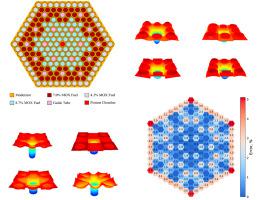当前位置:
X-MOL 学术
›
Prog. Nucl. Energy
›
论文详情
Our official English website, www.x-mol.net, welcomes your
feedback! (Note: you will need to create a separate account there.)
Verification of the current coupling collision probability method with orthogonal flux expansion for the assembly calculations
Progress in Nuclear Energy ( IF 3.3 ) Pub Date : 2020-12-01 , DOI: 10.1016/j.pnucene.2020.103562 Dzianis Litskevich , Seddon Atkinson , Sebastian Davies
Progress in Nuclear Energy ( IF 3.3 ) Pub Date : 2020-12-01 , DOI: 10.1016/j.pnucene.2020.103562 Dzianis Litskevich , Seddon Atkinson , Sebastian Davies

|
Abstract The operation of nuclear reactors requires detailed knowledge of important safety parameters, such as the spatial power distribution, control rod worth, margin to departure from nucleate boiling (DNB), fuel pin burnup etc. To obtain a detailed analysis of all of the safety parameters requires a full core pin-by-pin coupled neutronics and thermal-hydraulics simulations which are too computationally expensive even for modern high-performance computer clusters. Therefore, the industrial standard approach in design and safety calculations are coupled neutronics and thermal-hydraulics codes for the steady state and transient simulations. In these codes, the neutronics calculations are typically performed at a nodal level using the diffusion approximation and assembly-homogenised sets of cross-sections while the thermal hydraulics relies on a channel model with fuel assembly sized channels. However, for determining safety limits, which are based on local pin-based parameters, the knowledge of the power and temperature distribution on a nodal level is not sufficient. Therefore, novel new approaches are required to resolve this multiscale and multiphysics problem to resolve the power distribution within the zones of interest. Pin-wise calculations, in this case, are performed by applying a transport solver using the heterogeneous fuel assembly geometry on an unstructured mesh with boundary conditions extracted from the 3D full core nodal diffusion solution. This combined nodal-transport approach will provide the detailed power distribution on the pin-level and perform coupled multiphysics simulations within reasonable simulation time limits, which is important for industry. To follow this strategy, a transport solver is required which can be used for the flux reconstruction on the pin level. Current coupling collision probability (CCCP) method seems to be a good choice for the development of such a solver. In this study, the developed transport solver utilising CCCP method with orthogonal flux expansion is tested and verified on the set of the benchmark problems. The results of simulations are compared with the results of Monte Carlo and deterministic code. The expansion of the flux by orthogonal polynomials allows us to avoid discretisation of the calculation regions while keeping the accuracy of the calculations to an acceptable level. The results of the calculations demonstrate good agreement with the results of Monte Carlo calculations. The comparison of the new method with the flat flux (today's industry standard approach) approximation demonstrates either an improved quality of the result for identical cell discretisation or reduced computational time to achieve the identical solution.
中文翻译:

用正交通量扩展验证当前耦合碰撞概率方法用于装配计算
摘要 核反应堆的运行需要详细了解重要的安全参数,例如空间功率分布、控制棒价值、远离核沸腾 (DNB) 的裕度、燃料棒燃耗等。参数需要一个完整的核心逐针耦合中子学和热工水力模拟,即使对于现代高性能计算机集群来说,这在计算上也太昂贵了。因此,设计和安全计算中的工业标准方法是用于稳态和瞬态模拟的耦合中子学和热工水力代码。在这些代码中,中子学计算通常使用扩散近似和组件均质化的横截面组在节点级别执行,而热力水力学依赖于具有燃料组件大小通道的通道模型。然而,为了确定基于局部引脚参数的安全限制,节点级别上的功率和温度分布的知识是不够的。因此,需要新的新方法来解决这个多尺度和多物理场问题,以解决感兴趣区域内的功率分布。在这种情况下,引脚方向计算是通过在非结构化网格上使用异构燃料组件几何形状应用传输求解器来执行的,边界条件是从 3D 完整核心节点扩散解中提取的。这种结合节点传输的方法将提供引脚级的详细功率分布,并在合理的仿真时间限制内执行耦合多物理场仿真,这对工业很重要。要遵循此策略,需要一个传输求解器,可用于引脚级别的通量重建。电流耦合碰撞概率 (CCCP) 方法似乎是开发此类求解器的不错选择。在本研究中,开发的利用 CCCP 方法和正交通量扩展的输运求解器在一组基准问题上进行了测试和验证。将仿真结果与蒙特卡罗和确定性代码的结果进行比较。正交多项式对通量的扩展使我们能够避免计算区域的离散化,同时将计算的准确性保持在可接受的水平。计算结果与蒙特卡洛计算结果吻合良好。新方法与扁平通量(当今的行业标准方法)近似值的比较表明,相同单元离散化的结果质量有所提高,或者实现相同解的计算时间减少。
更新日期:2020-12-01
中文翻译:

用正交通量扩展验证当前耦合碰撞概率方法用于装配计算
摘要 核反应堆的运行需要详细了解重要的安全参数,例如空间功率分布、控制棒价值、远离核沸腾 (DNB) 的裕度、燃料棒燃耗等。参数需要一个完整的核心逐针耦合中子学和热工水力模拟,即使对于现代高性能计算机集群来说,这在计算上也太昂贵了。因此,设计和安全计算中的工业标准方法是用于稳态和瞬态模拟的耦合中子学和热工水力代码。在这些代码中,中子学计算通常使用扩散近似和组件均质化的横截面组在节点级别执行,而热力水力学依赖于具有燃料组件大小通道的通道模型。然而,为了确定基于局部引脚参数的安全限制,节点级别上的功率和温度分布的知识是不够的。因此,需要新的新方法来解决这个多尺度和多物理场问题,以解决感兴趣区域内的功率分布。在这种情况下,引脚方向计算是通过在非结构化网格上使用异构燃料组件几何形状应用传输求解器来执行的,边界条件是从 3D 完整核心节点扩散解中提取的。这种结合节点传输的方法将提供引脚级的详细功率分布,并在合理的仿真时间限制内执行耦合多物理场仿真,这对工业很重要。要遵循此策略,需要一个传输求解器,可用于引脚级别的通量重建。电流耦合碰撞概率 (CCCP) 方法似乎是开发此类求解器的不错选择。在本研究中,开发的利用 CCCP 方法和正交通量扩展的输运求解器在一组基准问题上进行了测试和验证。将仿真结果与蒙特卡罗和确定性代码的结果进行比较。正交多项式对通量的扩展使我们能够避免计算区域的离散化,同时将计算的准确性保持在可接受的水平。计算结果与蒙特卡洛计算结果吻合良好。新方法与扁平通量(当今的行业标准方法)近似值的比较表明,相同单元离散化的结果质量有所提高,或者实现相同解的计算时间减少。









































 京公网安备 11010802027423号
京公网安备 11010802027423号